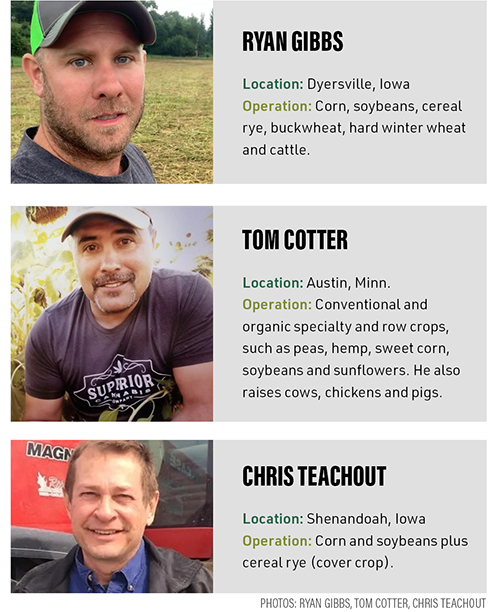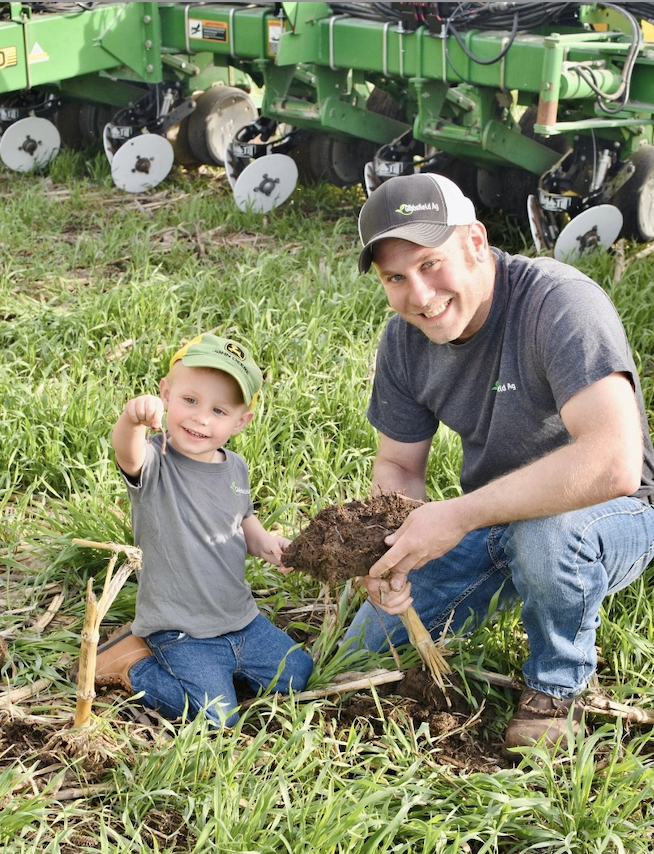Producers Eliminate Fungicide and Insecticide Use, Cut Fertilizer 50%

To combat volatile weather, mitigate rising input costs and meet agronomic goals, producers are making choices geared toward soil health. Here are insights and tips from three of those producers.

Q: What kind of regenerative practices do you use?
GIBBS: About four years ago we transitioned all of our acres to no-till and cover crop, and we started making our own biological in 2021.
COTTER: In 1998 we started using cover crops and strip-till, then transitioned to no-till in 2016, with one-third of my acres in an organic program. We also use biologicals and graze livestock on all our acres.
TEACHOUT: We’ve used cover crops and no-till since the mid-1980s. In the past three years we added biologicals.
Q: What chemicals and nutrients are you using and at what rates?
GIBBS: We don’t do fungicide or insecticide. Around 80% of my fertilizer is sourced through livestock (hog manure and grazing cattle). The remaining 20% is in humic and
fulvic acid, nitrogen, sulfur, boron and zinc. For example, last year we put 20 lb. of nitrogen on at V6.
COTTER: I have cut my fertilizer back 50%, introduced 150 head of livestock and started using biologicals. We don’t use any fungicide or insecticide. The soybeans won’t see a treatment, but corn usually has a light treatment. For organic, the inputs are chicken or turkey litter.
Q: Are there new crops in your rotation since adding regenerative practices? Have you been able to find a market for these crops?
GIBBS: The wheats are new to us, but there’s always someone looking to buy from us in our area. They say they don’t know where else to get it.
COTTER: We introduced hemp, CBD, sunflowers, grain and fiber. The producer who helped me get into sunflowers was the one who helped me get a foot in the market door.
Q: Since implementing these practices, what changes have you seen in your soil?
COTTER: Our weed pressure went way down right away, and that’s how I fell into organic so quickly. The water infiltration shot up and the biodiversity with worms was seen within that first growing season.

TEACHOUT: It’s a nice chocolate cake texture and has an aggregated structure with high water infiltration. I noticed a difference about 10 years ago when we started intensifying our cover crops. I saw another change right after we introduced biologicals.
Q: When did the new practices start to pencil out?
GIBBS: In the first year of cover crop and no-till, we saw no change. As we continued to lean into biologicals, minimizing fungicide and getting the soil back on track, we saw our yields go up and our inputs go down. That cost savings makes you want to experiment even more.
Q: How did you come to learn about soil biology?
GIBBS: I got a microscope, watched numerous YouTube videos and listened to speakers on podcasts and at events.
TEACHOUT: When I dispersed my cattle herd, I became more interested in the “livestock underground.” I was bored and felt like I could get more out of crops, so I took up self-study, attended events and listened to soil scientists all across the nation and from other countries.
Q: What’s one thing you wish conventional producers knew about soil biology?
GIBBS: Fungicide isn’t helpful; killing good and bad fungi isn’t helpful to soil or crops.
COTTER: Killing all soil life makes your crops more susceptible to insects and disease — they’re looking for the weak, easy target. Fields with good and bad predators will create an equilibrium that works on its own, without our help.
Q: What knowledge have you obtained through this process that you wish you would have known right out of the gate?
GIBBS: Finding ecological harmony by reintroducing insects, like bees, is key.
TEACHOUT: Water infiltration possibilities with regen would have been nice to know. We had the NRCS come out for a test years ago. They poured water on our soil to mirror 5-in. of rain in two minutes. Our soil held every drop of water.
Mitchell Hora, founder of Continuum Ag, says his operation has been using no-till as far back as 1978, and cover crops since 2013. But with years of experience, it can still be unpredictable.
“Nature doesn’t work in a straight line or do math equations like we want it to,” says Hora. “You have to figure out what would best work for your own operation.”
To get started and be successful in the regenerative ag space, Hora recommends producers:
• Be curious and ask questions
• Learn through other people
• Experiment on your operation
• Foster patience







